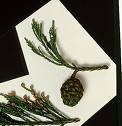Sequoiadendron Giganteum Tree Information
Images of Sequoiadendron Giganteum:






Sequoiadendron Giganteum grows in the following 2 states and provinces:
California, HawaiiInformation about Sequoiadendron Giganteum:
The Sequoiadendron Giganteum is commonly known as the Bigtree as well as Giant Sequoia.
The currently accepted scientific name for giant sequoia is Sequoiadendron giganteum (Lindl.) Buchholz . There are no recognized subspecies, varieties, or forms.The natural distribution of giant sequoia is restricted to about 75 groves, comprising a total area of only 35,607 acres (14,416 ha) along a limited area of the western Sierra Nevada, California. The northern two-thirds of its range, from the American River in Placer County southward to the Kings River has only eight disjunct groves. The remaining groves are concentrated between the Kings River and the Deer Creek Grove in southern Tulare County . Groves range in size from approximately 2,470 acres (1,000 ha) with 20,000 giant sequioas to small groves with only six living trees .Giant sequoia principally occurs in scattered groves. Nowhere does it grow in pure stands, although in a few small areas stands do approach a pure condition . Although the giant sequoia groves of the central and southern Sierra Nevada represent only a specific mesic segregate of typical white fir (Abies concolor) forest communities, these groves are often given special community recognition. Only giant sequoia is restricted to the groves . Typically, giant sequoia is found in a mixed conifer type dominated by California white fir (A. concolor var. lowiana). Characteristic associates include sugar pine (Pinus lambertiana), Jeffrey pine (P. jeffreyi), ponderosa pine (P. ponderosa), Douglas-fir (Pseudotsuga menziesii), incense-cedar (Calocedrus decurrens), and California black oak (Quercus kelloggii). Shrub types include bush chinkapin (Castanopsis sempervirens) and mountain whitethorn (Ceanothus cordulatus) . Giant sequoia as a dominant species in the following typings: Terrestrial natural communitites of California Montane and subalpine vegetation of the Sierra Nevada and Cascade Ranges Some of the information provided here is attributed to:Habeck, R. J. 1992. Sequoiadendron giganteum. In: Fire Effects Information System, [Online]. U.S. Department of Agriculture, Forest Service, Rocky Mountain Research Station, Fire Sciences Laboratory (Producer). , available at the USDA Fire Effects Information System (FEIS) website